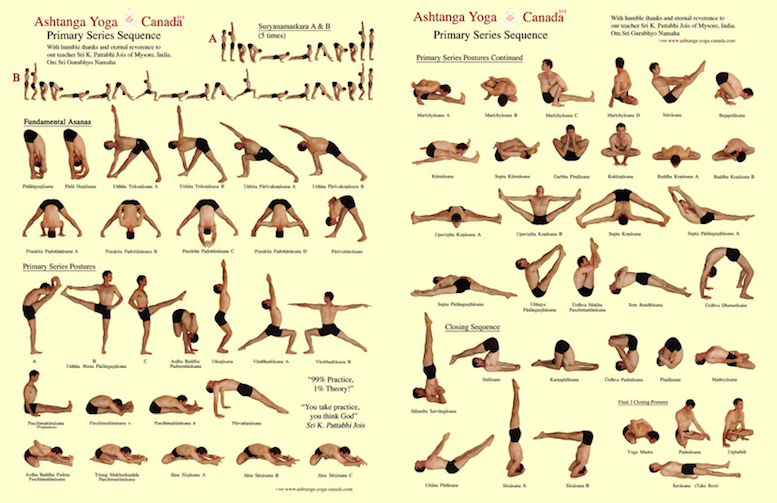Good day, Steemians!
Discipline is remembering what you want. -- David Campbell
Ashtanga yoga is a highly disciplined, structured practice with plenty of solar, masculine energy. That can be sweet: the hatha (movement based) practice programs muscle memory so the mind can cool it, or challenging: the same series of poses every day can get boring, plus the high strain of a few repetitive motions may cause injury if alignments are overlooked. It's all in perspective.
I build my practice on a foundation of ashtanga, and there's much more to this style than physical poses. The sage Patanjali described the 8 limbs of this style in the Yoga Sutras some 2,500 years ago:
- Yamas = 5 restraints: ahimsa (non-violence), satya (truth), asteya (non-stealing), brahmacharya (focus of life energy), aparigraha (non-coveting)
- Nimaya = 5 observances: saucha (cleanliness), santosha (contentment), tapas (fire), svadhyaya (self-study), ishvara pranidhana (surrender)
- Asanas = poses/postures
- Pranayama = breath control
- Pratyahara = sense withdrawal
- Dharana = concentration
- Dhyani = meditation
- Samadhi = enlightenment
Each of these limbs can fill volumes. So far, my focus in these "How to Yoga" posts has been asanas, because movements are fairly straightforward for new practitioners; you can immediately feel the effects of moving the body in particular ways and reap the benefits of yoga.
Yoga is 99% practice and 1% theory. -- Pattabhi Jois
Primary series, or Yoga Chikitsa (yoga therapy), is a great place for the beginner to start an asana practice. This routine always follows the same sequence of poses. As the yogi/yogini becomes more capable and confident in their yoga abilities, they can advance through second series (Nadi Shodana = nerve cleansing), and advanced series A, B, C, and D (also called Sthira Bhaga = divine grace).
This is primary series:
Vinyasas (= half series = essentially a sun salutation) serve as transitions between each and every pose; classically, a vinyasa is performed even for switching sides on a pose.
It's often done in Mysore style, so named for the city of Mysore, India where Pattabhi Jois taught. This is like an individual practice done in a group setting; there is no single instructor to follow, and only the sound of breathing fills the room. This feels very natural to me; I'm not a fan of every person doing the same movements at the same pace, which is what you find in almost all Western yoga classes. I believe the "teacher" is there to encourage proper alignments and to show the "student" how to develop a sustainable self-practice. Truly, the individual is the most important person in a yoga practice, and it is up to them to tune into their own breath and ability instead of a leader telling them what to do.
Whether done on your own or in a class setting, primary series is a great place to begin for establishing a daily practice. Once you get the hang of it, you recognize the pattern: begin with a warm up of sun salutations A & B, move into standing poses, then seated, then inversions, backbends, and finishing poses.
Yoga's super radical in that it teaches the yogi how to feel and harness his own power - feel free to give your body exactly what it needs each and every day! You may favor hip openers as part of your seated series over twists some days, or vice versa.
I find it beneficial to return to classic primary series if I'm feeling resistant to a daily asana practice, and I hope this inspires and motivates you to care for your body, mind, and spirit - you totally deserve it!
There is so much more to come; we have only dipped our toes into the ocean of yoga!
💛 Sara!


